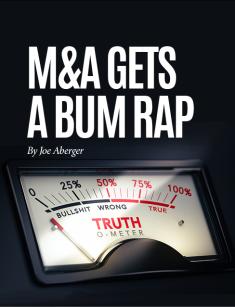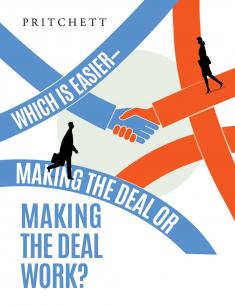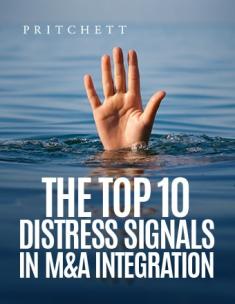By Joe Aberger
The assumption that most mergers fail is repeated so often that few challenge it.
Studies from reputable sources have helped create and keep this myth alive:
- KPMG researched 700 mergers and calculated 83% were unsuccessful in creating shareholder value.
- A McKinsey study found that 61% of acquisition programs did not earn back their cost of capital.
- Mercer Management determined that the returns to shareholders of 57% of 300 major merged companies lagged behind their industry averages.
- A.T. Kearney examined 115 transactions, each greater than $1 billion in size, and reported 58% reduced shareholder value.
Major publications also report disappointing merger results:
- A Business Week article entitled “Why Most Big Deals Don't Pay Off” summarized the study that found the average returns to acquirers were 25% lower than their industry peers.
- A Wall Street Journal article observed that eight of the fifteen largest mergers over the last five years trailed the returns of the S&P 500.
- The Economist declared mergers have an even higher failure rate than the liaisons of Hollywood stars.
The media can be awfully pessimistic about the prospects for M&A success. The New York Times sums up the conventional wisdom on corporate marriages:
“Most mergers fail. If that's not a bona fide fact, plenty of smart people think it is. McKinsey & Company says it's true. Harvard too. Booz Allen Hamilton, KPMG, AT Kearney. The list goes on. If a deal enriches an acquirer’s shareholders, the stats say, it's probably an accident.”
If M&A is a loser’s game, why do CEOs continue to play it? Why do they still pursue acquisitions?
Because most executives don't buy into the gloom and doom M&A numbers. The failure rates are exaggerated. The majority of mergers do not destroy shareholder value. It is certain types of mergers at certain times, not all mergers, that are likely to generate negative returns. The M&A samples in the aforementioned studies included a disproportionate high number of large deals that took place during bull markets. Because of the size and timing of the mergers in the samples researched, the findings from these studies were negatively skewed.
In M&A, both timing and size matter. These two factors often determine whether a merger study reports negative or positive findings. Researchers from Wake Forest, Ohio State, and the University of Pittsburgh showed how the losses from a few mega-sized mergers can offset all the gains from thousands of other mergers.
Their study examined 12,023 US deals greater than $1 million that took place over a 21-year period. These mergers generated an aggregate loss of $220 billion. 87 of the 12,023 mergers lost a total of $396 billion. That's about seven tenths of 1% of the total mergers in the study. A mere seven tenths of 1% racked up shareholder losses of $396 billion.
The balance, the other 99.3% of mergers, when you add up all their gains and losses, they generated total shareholder gains of $176 billion. If you looked at only one number, the aggregate $220 billion loss, you might reach the incorrect conclusion that most mergers fail. Actually, a relatively few mergers concentrated in one four-year period produced the huge losses. All 87 money-losing deals were announced during a bull market. 87 titanic deals in four years wiped out all the gains from thousands of other deals from over two decades.
The outliers in M&A studies, the deals that generate incredible losses, fit a particular profile. They usually share several characteristics:
- They are very large acquisitions
- The deals are announced during bull markets
- The buyer’s stock has outperformed the market
- And the buyers use their high-priced stock to purchase the target company
The buyers, due to their elevated valuations, are often referred to as glamour acquirers. The post-merger performances of glamour acquirers were examined by researchers from the University of Chicago and London Business School. Their study reported that over three years, glamour acquirers generated negative excess returns of 57%, whereas value acquirers earned positive excess returns of 36%. Glamour acquirers have high market to book values, whereas value acquirers do not.
On average, glamour acquirers perform badly after their deals. What could explain this? Well, an acquirers view of its stock price can diverge from the markets view. Glamour acquires may know they're near the high point of good fortune for their firm or industry and their stock is overvalued. Before their pricey stock takes a nose-dive, they use it as currency to purchase a target company. At some point, the stock market corrects the acquirer's temporary overvaluation. Part or all of the acquirer’s future stock losses are due to the correction. Yet the acquisition often takes most of the blame for the reversal of fortune.
A merger can fail on paper, but not actually be a failure if the acquirer’s negative post-merger shareholder returns would have been worse, even more negative without the acquisition. Sometimes, executives make acquisitions to minimize the damage from approaching threats. In these situations, the value destruction after the merger may be primarily due to the very problems executives anticipated, rather than the acquisitions themselves. Future problems can take the form of deregulation or regulation, technological change, new competitors, or a market correction. Companies that are overvalued and facing a future market correction are caught between a rock and a hard place. If they don't acquire, their value will decline, and if they do acquire, their value will decline.
In 2000, America Online found itself in that “no win” situation. The company was overvalued, and it decided to acquire Time Warner. The AOL Time Warner merger, the largest deal in American history at that time has been portrayed as an epic disaster in countless articles and books. AOL's value declined by many tens of billions of dollars in the years following the acquisition announcement. On the surface, AOL Time Warner does appear to be one of the worst mergers in history, but was it really?
AOL announced its acquisition of Time Warner in January 2000. At that time, the tech bubble had not yet burst. AOL’s share price was near its peak. From January 1998 to January 2000, AOL's valuation increased by more than 1,100%. That's 22 times more than the increase in the S&P 500 over the same period.
In early 2000, AOL fit the profile of a glamour acquirer. It was overvalued as were many other technology companies. Then in 2000, the NASDAQ declined 39%. Then it dropped an additional 21% in 2001 and lost another 31% in 2002. A large part of AOL's post-merger losses was due to this market correction. In the year preceding AOL's acquisition announcement, technology stock prices were near the end of their historic ascent. And AOL's business model was aging. The world was moving away from AOL's dial-up service and toward high-speed Internet access. Maybe AOL saw the writing on the wall and in a defensive move, purchased the hard assets of Time Warner. The stock-for-stock merger effectively transferred part of AOL's future stock losses from AOL to Time Warner shareholders. This deal was awful for Time Warner investors. It probably felt like the worst merger in history to them. But as Robert Bruner points out in his book, Deals from Hell, AOL investors probably lost less money than they otherwise would have lost if AOL remained a standalone company.
There is a consensus among researchers that, on average, acquisitions made when the economy is strong perform worse than those executed in recessions. In fact, they usually perform much worse.
- Bain and Company reported that acquisitions during or just after a recession generated almost 300% more than the returns of acquisitions made during the preceding boom years.
- Boston Consulting Group found that weak economy deals are almost two times as likely as strong economy deals to generate shareholder gains greater than 50%.
Timing impacts returns. Every stock market cycle has a boom and a bust. A strong economy and high stock valuations are associated with the booms. With everything else equal, it's best for acquirers to buy during the bust when prices are lower. Lower prices translate into higher M&A returns. Generally, buyers get more for their money in a recession. And due to lower valuations, they may be able to go after targets that were previously out of their reach. Lean times can present excellent buying opportunities.
The most publicized research leaves the impression that at all times, the chances for M&A success are a long shot. One study concluded acquirers would have better luck at the crap tables in Las Vegas.
Too many studies examine mergers in one time period and then blindly generalize the findings to mergers at all times. Some acquirers suffer big post-merger losses, but not most of them. The mega-sized stock-financed mergers executed in hot markets account for the bulk of the poor shareholder returns found in M&A studies.
Keep in mind variables other than a merger also impact stock prices, so negative post-merger stock returns don't necessarily mean an acquisition failed. A lot of research has been conducted to discover the true performance of mergers. Many studies report that acquisitions generate below industry returns, while many other studies report just the opposite. The findings in M&A research are mixed, primarily because from study to study, the number of glamour acquirers, the number of stock-financed deals, the methodologies employed, and the time periods examined all vary.
Unfortunately, negative research results appear to grab more attention. But overall, if you weigh the studies that report negative findings with those that report positive ones, they tend to balance each other out. Be skeptical of M&A research results that are extremely positive or negative.
KPMG asked senior executives in 107 acquisitive companies if the deals they executed were a success. An overwhelming 82% said yes. Obviously, many of these executives did not provide unbiased, accurate assessments of how their deals actually performed. An 82% success rate is absurdly too high, just as the terrible success rates circulated online are absurdly too low. On average and over time, it's reasonable to conclude that about 50% of mergers succeed.
The economic laws of supply and demand help limit both the downside and the upside of M&A. If acquisitions are producing positive above industry returns, more buyers will make acquisitions. The increased competition for target companies will increase the prices paid, and that will tend to push post-merger positive returns down toward zero. If acquisitions are generating negative below industry returns, fewer buyers will make acquisitions. The decreased competition for target companies will decrease the prices paid. And that will tend to raise negative post-merger returns up toward zero. On average, acquisitions roughly break even. In other words, the forces of supply and demand overtime tend to eliminate excess losses and excess profits.
Here's another way to look at it. An acquisition is an investment. An investment is not a failure if it produces returns equal to or greater than its cost of capital. Averages conceal a great deal of variation. But on average, like other corporate investments, acquisitions earn back their cost of capital. However, mergers are usually larger, more conspicuous, and subject to much greater scrutiny than other investments. The hypercritical attention paid to M&A and the blanket negative assertions from many research studies have given mergers a bum rap. It would be unfortunate if an organization did not consider acquisitions solely because of the misinformation about M&A failure rates.
In my experience on post-merger integrations over the past three decades, most acquisitions do not fail. Having said that, M&A is not a road to easy riches. Acquisitions are not for the faint hearted. They involve substantial risk, but sometimes doing nothing poses an even greater danger. The best defense can be a good offense. Purchasing the right company at the right price and integrating it successfully may be the most effective way to protect a competitive advantage or develop a new one. Often, a strategy cannot be achieved, and shareholder value created by relying solely on organic growth.





